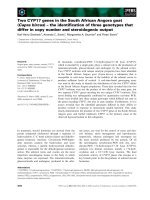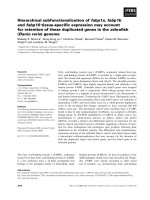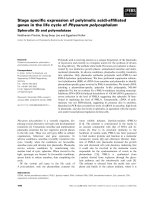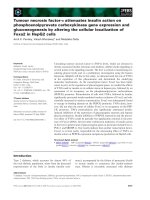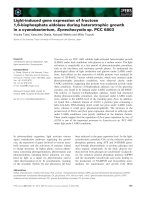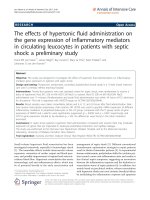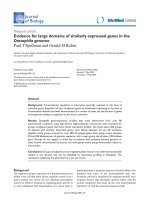Sexual biased gene expression of olfactoryrelated genes in the antennae of conogethes pinicolalis (lepidoptera crambidae)
Bạn đang xem bản rút gọn của tài liệu. Xem và tải ngay bản đầy đủ của tài liệu tại đây (766.66 KB, 7 trang )
Jing et al. BMC Genomics
(2020) 21:244
/>
RESEARCH ARTICLE
Open Access
Sexual-biased gene expression of olfactoryrelated genes in the antennae of
Conogethes pinicolalis (Lepidoptera:
Crambidae)
Dapeng Jing1,2, Tiantao Zhang1* , Shuxiong Bai1, Kanglai He1, Sivaprasath Prabu1, Junbo Luan2 and
Zhenying Wang1*
Abstract
Background: Conogethes pinicolalis (Lepidoptera: Crambidae), is similar to Conogethes punctiferalis (yellow peach
moth) and its host plant is gymnosperms, especially for masson pine. So far, less literature was reported on this
pest. In the present study, we sequenced and characterized the antennal transcriptomes of male and female C.
pinicolalis for the first time.
Results: Totally, 26 odorant-binding protein (OBP) genes, 19 chemosensory protein (CSP) genes, 55 odorant
receptor (OR) genes and 20 ionotropic receptor (IR) genes were identified from the C. pinicolalis antennae
transcriptome and amino sequences were annotated against homologs of C. punctiferalis. The neighbor-joining tree
indicated that the amino acid sequence of olfactory related genes is highly homologous with C. punctiferalis.
Furthermore, the reference genes were selected, and we recommended the phosphate dehydrogenase gene
(GAPDH) or ribosomal protein 49 gene (RP49) to verify the target gene expression during larval development stages
and RP49 or ribosomal protein L13 gene (RPL13) for adult tissues.
Conclusions: Our study provides a starting point on the molecular level characterization between C. pinicolalis and
C. punctiferalis, which might be supportive for pest management studies in future.
Keywords: Conogethes pinicolalis, Conogethes punctiferalis, Yellow peach moth, Transcriptomics, OBP, GOBP, PBP,
RNA-Seq, Transcriptome
Background
Olfaction system plays a key role in insects, which includes kin recognition, mediating foraging, aggregation, toxic compound avoidance and oviposition
behaviors. However, the olfaction is a complex network that contains odorant-binding proteins (OBP),
odorant receptors (OR), chemosensory proteins (CSP),
* Correspondence: ;
1
State Key Laboratory for Biology of Plant Diseases and Insect Pests, Institute
of Plant Protection, Chinese Academy of Agricultural Sciences, Beijing
100193, China
Full list of author information is available at the end of the article
sensory neuron membrane proteins (SNMPs), ionotropic receptors (IR) and odorant degrading enzymes
(ODEs). They form a functional network with each
other in detecting different odorants types, thus
complete the odorants recognition process [1, 2]. In
Lepidoptera, OBPs are composed of pheromonebinding proteins (PBPs), general odorant-binding proteins (GOBPs) and antennal binding proteins (ABPs),
and they combined to detect a wide range of odors
and transport hydrophobic odorants to the ORs or
IRs [3]. The functions of CSPs are also similar to
© The Author(s). 2020 Open Access This article is licensed under a Creative Commons Attribution 4.0 International License,
which permits use, sharing, adaptation, distribution and reproduction in any medium or format, as long as you give
appropriate credit to the original author(s) and the source, provide a link to the Creative Commons licence, and indicate if
changes were made. The images or other third party material in this article are included in the article's Creative Commons
licence, unless indicated otherwise in a credit line to the material. If material is not included in the article's Creative Commons
licence and your intended use is not permitted by statutory regulation or exceeds the permitted use, you will need to obtain
permission directly from the copyright holder. To view a copy of this licence, visit />The Creative Commons Public Domain Dedication waiver ( applies to the
data made available in this article, unless otherwise stated in a credit line to the data.
Jing et al. BMC Genomics
(2020) 21:244
OBPs, localized in the lymph of trochoid sensilla [4].
IRs or ORs are localized on the dendrite of the chemosensory neuron, which can transform the chemical
signals from OBPs or CSPs into an electric signal and
transmit to the brain [5, 6]. The SNMPs and ODEs
are regarded to trigger ligand delivery to the receptor
and terminate the signal stimulation, respectively [6].
Conogethes pinicolalis (Lepidoptera: Crambidae), is a
sibling species of Conogethes punctiferalis (Lepidoptera:
Crambidae). Morphological features of C. pinicolalis egg,
larva, pupa and adult resemble those of C. punctiferalis
and it is considered as same species. In 1963, Koizumi firstly identified the C. pinicolalis as an another
type of yellow peach moth and classified as pinaceaefeeding type (PFT) [7]. Later, Honda and Mitsuhashi
identified and distinguished the difference between
these pests in the adults, larvae and pupal stages [8];
Konno et al. reported that they were different species
from their response to different spectra of host-plant
constituents [9]; In 2006, the pinaceae-feeding type
was named as C. pinicolalis [10]. Though these
studies have provided important information regarding the identification of species, it is not entirely reliable because these insect groups were undergoing
speciation, genomic changes, or evolving into new
taxon [11]. Therefore, for its high reliability, molecular characterization technique can serve as a complementary method for further analysis. Especially, DNA
sequencing and mitochondrial DNA (mtDNA) have
been successfully used to deal with the species uncertainty
in morphological taxonomy [12–14]. For example, Shashank integration of conventional taxonomy, DNA bar
code and others methods successfully confirmed the difference in populations of Conogethes which reared on
castor and cardamom in India [11]. Furthermore, Wang
et al. used mitochondrial DNA sequencing technique to
verify C. pinicolalis and C. punctiferalis were significantly
different species [15].
C. pinicolalis is a typical oligophagous pest that can
only feed on Pinus massoniana (masson pine) and few
pine trees. However, as a sibling species, C. punctiferalis,
is a polyphagous pest that can infest hundreds of plants
[9, 16]. High-throughput sequencing technology can
provide us with a lot of data and it has greatly promoted
the research on entomology [17, 18]. In this study, we
analyzed the difference of male and female antennae
transcriptome and identified the olfactory genes from
Gene Ontology (GO) annotation as well as sets of putative OBPs, CSPs, ORs and IRs in C. pinicolalis. Furthermore, we compared the difference of the genes with C.
punctiferalis. These results provide basically data for the
study of C. pinicolalis olfactory genes, also may help to
better understand the genetic evolution between these
two sibling species.
Page 2 of 13
Results
Overall sequence analysis
A total of 78,199,136 and 75,969,652 raw reads were obtained from male and female antennae, respectively. We obtained 77,254,390 and 74,994,240 clean reads from male and
female antennae after trimming adapter sequences, eliminating low-quality reads, and N represented sequences. A total
of 98,214 unigenes were obtained with an average length of
815 bp and with a N50 of 2968 (Table 1). The raw reads of
the C. pinicolalis are available from the SRA database (accession number: SRX5250688, SRX5250689, SRX5250690,
SRX5250691, SRX5250692 and SRX5250693).
Functional annotation of the C. pinicolalis antennal
unigenes
In total, 98,214 unigenes were successfully annotated in all
databases (Table 2), including 47,089 (47.94%) unigenes
matched to known proteins and 33,852 unigenes (34.46%)
in the Swiss-Prot database. GO analysis was used to classify the biological process, molecular function and cellular
components (Additional file 1: Figure S1A). Under the
molecular function category, the genes expressed in the
antennae were mostly related to binding, catalytic activity
and transporter activity (Additional file 1: Figure S1B).
From the Kyoto Encyclopedia of Genes and Genomes
(KEGG) annotation, 10,298 unigenes were classified into
five groups, cellular processes, environmental information
processing, genetic information processing, metabolism
and organismal systems (Additional file 1: Figure S1C).
Olfactory-related genes in the C. pinicolalis antennae
Totally, 26 OBP genes, 19 CSP genes, 55 OR genes and
20 IR genes were identified from the C. pinicolalis antennae (Additional file 2: Table S1). Among the identified OBP genes, we found 4 PBP, 2 GOBP and 20 other
kinds of OBP genes. Furthermore, OBP and CSP genes
are detected in male and female antennae and showed
the significant differences in genes abundance (P < 0.05)
(Fig. 1). Interestingly, PBP2, OBP13 and OBP15 are male
biased expression, whereas the other PBPs (PBP1, PBP3
and PBP4), as well as GOBPs (GOBP1 and GOBP2) are
female bias expression. Furthermore, two of the other
Table 1 Summary of assembled contigs and unigenes
Type (bp)
Contigs
Unigenes
Total number
121,650
98,214
Total length
160,640,609
154,441,888
Min length
201
201
Mean length
568
815
Maximum length
25,856
25,856
N50
2825
2968
N90
467
612
Jing et al. BMC Genomics
(2020) 21:244
Page 3 of 13
Table 2 Summary of annotations of unigenes
Type (bp)
Number of
Unigenes
Percentage (%)
Annotated in NR
47,089
47.94
Annotated in NT
31,124
31.68
Annotated in KO
18,774
19.11
Annotated in SwissProt
33,852
34.46
Annotated in PFAM
37,710
38.39
Annotated in GO
37,882
38.57
Annotated in KOG
19,474
19.82
Annotated in all Databases
8967
9.13
Annotated in at least one
Database
59,764
60.85
Total Unigenes
98,214
100
are highly expressed in female antennae with differential fold change (FC) > 5. Six ORs with 2.0 < FC < 5.0
(P < 0.05) and eight ORs with 1.5 < FC < 2.0 (P < 0.05)
(Fig. 2a). Three IR genes (IR75p2, IR75d and IR4)
showed female biased expression (p < 0.05) and other
four genes (IR2, IR75p2, IR75p, and IR64a) were male
biased expression (p < 0.05) (Fig. 2b).
Significantly expressed genes were confirmed by quantitative real-time PCR (RT-qPCR) (Additional file 1:
Figure S2). Expressions of female biased genes from class
OBP (PBP1, PBP3, PBP4, GOBP1, GOBP2, OBP6, OBP7
and OBP9) were enormously consistent with the transcripts per kilobase million (TMP) values.. The same results were obtained in the expression of CSPs, ORs and
IRs (Additional file 1: Figure S2).
Phylogenetic analysis
OBPs (OBP7 and OBP9) remained female biased expression (Fig. 1a). CSP genes (CSP4, CSP5, CSP14, CSP11 and
CSP17) showed female biased expression and significantly
different from the male (Fig. 1b), Other insignificantly
expressed genes were shown in Additional file 2: Table S1.
In OR gene sets, 7 pheromones receptors (PRs) and
47 other ORs were identified in male and female antennae. Three PR genes (OR1, OR3 and OR6), as well
as OR34, showed significantly higher expression in
male antennae. However, a large number of ORs
(about 18 genes) were significantly higher expression
in female antennae. Especially the OR48 and OR53,
Phylogenetic trees were constructed by using 95 OBPs, 157
ORs, 89 CSPs and 59 IRs from different species of Lepidoptera (Fig. 3; Additional file 1: Figure S3). The GOBP/PBP
genes sequences include six subgroups (GOBP1 and 2,
PBP1–4) formed a conserved order (Fig. 3). Furthermore,
OBPs, CSPs, ORs and IRs showed a very close relationship
with C. punctiferlis, only a few CSPs and IRs clustered with
other insects (Fig. 3; Additional file 1: Figure S3). Most of
the olfactory related genes showed more than 90% identity.
Moreover, 4 OBP, 5 OR, 2 IR and 2 CSP genes had 99%
sequence similarity with the C. punctiferlis (Table 3). ORs
and IRs genes indicated the Ostrinia furnacalis is the next
Fig. 1 Scatter plots showing the differential regulation of OBP and CSP genes in male and female C. pinicolalis antennae. Transcripts that exhibit
significant differences in abundance (P < 0.05), are color-coded according to their weighted fold change (FC). The expression levels are shown as
the mean Log10 (TPM + 1) for all of the three biological replicates for both sexes
Jing et al. BMC Genomics
(2020) 21:244
Page 4 of 13
Fig. 2 Scatter plots showing the differential regulation of OBP and CSP genes in male and female C. pinicolalis antennae. Transcripts that exhibit
significant differences in abundance (P < 0.05), are color-coded according to their weighted fold change (FC). The expression levels are shown as
the mean Log10 (TPM + 1) for all of the three biological replicates for both sexes
close neighbor in the same clade. On the other hand, OBPs
and CSPs genes showed Cnaphalocrocis medinalisin in the
same clade as a close neighbor after C. punctiferlis.
Olfactory-related genes in Bombyx mori showed gene divergence when compared with these two sibling species.
Reference genes selection
The gene stability results obtained from both the software seems to be similar (Fig. 4). In the adult tissues
(antanna, head, throax, abdomen, leg and wings) ribosomal protein 49 gene (RP49) and ribosomal protein L13
gene (RPL13) showed more stability than GADPH gene,
and Actin gene was unstable (Fig. 4b and d). However,
RPL13 performed unstable in different development
stages of the C. pinicolalis. The results of GeNorm software showed that Actin and phosphate dehydrogenase
gene (GAPDH) are the most stable gene (Fig. 2a); while
NormFinder software considered RP49 to be the most
stable gene (Fig. 4b).
Discussion
The application of next-generation sequencing technology in the field of entomology has greatly promoted the
efficiency and quantity of gene annotation [19]. Meantime, a lot of antennal transcriptomes olfactory-related
genes were identified [20–22]. In this research, we identified 26 OBP genes, 19 CSP genes, 55 OR genes and 20
IR genes from the C. pinicolalis antennal transcriptome,
these genes have been reported for the first time in this
species. C. pinicolalis is a sibling species of C.
punctiferlis, and had ever been recognized as the same
species [10]. In C. punctiferlis, totally 25 OBPs, 15 CSPs,
62 ORs and 10 IRs were identified from antennae transcriptome [23], and the numbers of OBPs, CSPs and ORs
are similar with C. pinicolalis, whereas more IRs were
identified from the C. pinicolalis antennal transcriptome
dataset, this may depend on the depth of the sequencing.
The sequence similarity of olfactory-related genes was analyzed and shown in the evolution tree (Fig. 3, Table 3),
OBP, CSP, OR and IR genes sequences showed high similarity with C. punctiferlis. Most of the identities are more
than 90%. 4 OBP, 5 OR, 2 IR and 2 CSP genes had 99% sequence similarity with the C. punctiferlis (Table 3). These
two pests were first identified by Koizumi et al. [7] and
classified into pinaceae-feeding type (PFT) and fruitfeeding type (FFT) based on their feeding habits and
morphological characters. They were later named as C.
pinicolalis and C. punctiferalis [10]. Further investigation
revealed their behaviors, morphologies, and feeding patterns, and indicated reproductive isolation between these
two types [9, 16, 18]. Wang et al. have shown that the C.
pinicolalis was different from that of C. punciferalis
through mitochondrial cytochrome c oxidase subunits I, II
and cytochrome b gene sequences [15]. The phylogenetic
tree also revealed an evolutionary relationship with other
Lepidopteran species. The GOBP/PBP genes sequences
include six subgroups (GOBP1 and 2, PBP1–4) formed a
conserved order (Fig. 3). ORs and IRs genes indicated the
Ostrinia furnacalis is also the close neighbor in the same
clade (Additional file 1: Figure S3). On the other hand,
Jing et al. BMC Genomics
(2020) 21:244
Page 5 of 13
Fig. 3 Phylogenetic relationship of olfactory-related gene from C. pinicolalis and other insects. Red font represents the genes from C. pinicolalis;
Cpun, Ofur, Bmor and Cmed are the abbreviation of C. punctiferalis, O. furnacalis, B. mori and Cnaphalocrocis medinalis, respectively
OBPs and CSPs genes showed Cnaphalocrocis medinalisin
in the same clade as a close neighbor after C. punctiferlis.
Olfactory-related genes in Bombyx mori showed gene divergence when compared with these two sibling species.
Menken et al. [24] suggested the two major transitions in the evolution of larval (Lepidoptera) feeding,
switching from litter-feeding to herbivory. Larvae
feeding on leaf-litter from a single dominant tree species would have been the main precursor for evolving
from litter-feeding to leaf-mining type. In the course
of evolution, leaf-mining type gained the new type of
enzymatic system to digest the nutritious freshly
fallen leaves. Once this evolved niche had been acquired the ability of leaf-mining and with the special
digestive system could apparently exploit the diversity
more and larval feeding mode had evolved in searching of new host-plants [25]. Insects olfaction system
allows them to recognize and track the volatile cues
from host-plant, mating and evade from their predators. The polyphagous insects significantly adapted to
recognize, digest and detoxify a large variety of hostplants. Polyphagous insects must handle the defensive
toxic molecules (secondary metabolites) produced by
the host-plant. Genes from the moth pheromone
glands could have evolved and altered the normal
fatty acid metabolism [26]. In a previous study, experiments proved the major change in the pheromone
blend in various moth species, the existence of different desaturase from mRNA in the moth pheromone
gland [27]. In Spodoptera frugiperda, due to tandem
duplications within a single region of the genome 10
OBP genes expansion was observed when compared
with B. mori. In the same study, the author showed a
difference in IRs gene count between the strains, S.
frugiperda corn strain had 42 IRs and rice strain had
43 IRs [28]. Similarly, in our study C. pinicolalis had
10 more IRs when compared with C. punctiferlis. Evidently, the selection of host plant is also a reason
that leads to gene duplications, insertions or deletions
when there is a need to adapt to an environment.
MK458359
MK458335
MK458336
MK458337
MK458338
MK458339
MK458340
OBP18
OBP19
GOBP1
GOBP2
PBP1
PBP2
PBP3
PBP4
MK458368
MK458358
OBP17
OR8
MK458357
OBP16
MK458367
MK458356
OBP15
MK458366
MK458355
OBP14
OR7
MK458354
OBP13
OR6
MK458353
OBP12
MK458365
MK458352
OBP11
MK458364
MK458351
OBP10
OR5
MK458350
OBP9
OR4
MK458349
OBP8
MK458363
MK458348
OBP7
MK458362
MK458347
OBP6
OR3
MK458346
OBP5
OR2
MK458345
OBP4
MK458361
MK458344
OBP3
OR1
MK458343
OBP2
Odorant-binding
proteins
Odorant
receptors
MK458342
Gene names
Gene family
C. pinicolalis
access No.
KX084459
KX084458
339
555
805
758
868
641
952
890
329
338
190
192
191
297
252
353
307
226
297
271
124
221
280
251
330
193
288
249
180
278
210
306
Score
3e-110
0
0
0
0
0
0
0
3e-106
1e-100
5e-33
2e-59
4e-57
3e-100
1e-82
5e-115
3e-104
3e-72
1e-97
2e-34
1e-34
2e-50
4e-89
1e-82
2e-112
1e-94
2e-95
2e-79
6e-94
77
90
95
95
92
94
99
95
93
95
95
97
99
95
97
99
98
97
98
95
88
98
94
99
98
95
97
96
99
74
96
5e −67
2e-91
97
% Identity
3e-102
E-value
ionotropic
receptors
Odorant
receptors
Gene family
IR25a
IR7
IR6
IR5
IR4
IR3
OR56
OR55
OR54
OR53
OR52
OR51
OR50
OR49
OR48
OR47
OR45
OR44
OR43
OR42
OR41
OR38
OR37
OR36
OR35
OR34
OR33
OR32
OR31
OR29
OR28
OR27
Gene names
MK458424
MK458422
MK458421
MK458420
MK458419
MK458418
MK458415
MK458414
MK458413
MK458412
MK458411
MK458410
MK458409
MK458408
MK458407
MK458406
MK458404
MK458403
MK458402
MK458401
MK458400
MK458397
MK458396
MK458395
MK458394
MK458393
MK458392
MK458391
MK458390
MK458388
MK458387
MK458386
C. pinicolalis
access No.
KX094508
KX084515
KX084514
KX084513
KX084512
KX084511
KX084506
KX084505
KX084504
KX084503
KX084502
KX084501
KX084500
KX084499
KX084498
KX084497
KX084495
KX084494
KX084493
KX084492
KX084491
KX084488
KX084487
KX084486
KX084485
KX084484
KX084483
KX084482
KX084481
KX084479
KX084478
KX084477
C. punctiferalis
access No.
1797
1089
1348
1484
1057
1299
690
839
853
691
728
647
800
114
437
299
508
684
581
686
644
657
735
409
882
444
774
712
564
734
586
740
Score
0
0
0
0
0
0
0
0
0
0
0
0
0
3e-23
1e-148
4e-100
3e-175
0
0
0
0
0
0
3e-98
0
1e-153
0
0
0
0
0
0
E-value
99
97
81
81
98
99
89
94
92
90
91
93
94
91
79
99
63
86
96
92
93
78
96
93
99
63
99
93
83
88
94
99
% Identity
(2020) 21:244
KX084457
KX084456
KX084455
KX084454
KX084453
KX084452
KP985227
KP985229
KP985228
MH006604
KT983812
KY130468
KY130475
KY130474
KY130473
KY130472
KY130470
KY130469
KY130467
KY130466
KY130465
KY130464
KY130463
KP985226
ALC76547
KP985224
KP985223
KP985222
KF026056
KF026055
C. punctiferalis
access No.
Table 3 Percentage identity of OBP, OR, IR and CSP gene family in C. pinicolalis with the sibling C. punctiferalis
Jing et al. BMC Genomics
Page 6 of 13
Gene family
C. pinicolalis
access No.
MK458369
MK458370
MK458371
MK458372
MK458373
MK458374
MK458375
MK458376
MK458377
MK458378
MK458379
MK458380
MK458382
MK458383
MK458384
Gene names
OR10
OR11
OR12
OR13
OR14
OR15
OR16
OR17
OR18
OR19
OR20
OR21
OR23
OR24
OR25
KX084475
KX084474
KX084473
KX084472
KX084471
KX084470
KX084469
KX084468
KX084467
KX084466
KX084465
KX084464
KX084463
KX084462
KX084461
C. punctiferalis
access No.
833
897
730
536
729
726
786
790
794
673
798
752
664
683
656
Score
0
0
0
3e-178
0
0
0
0
0
0
0
0
0
0
5e-165
E-value
93
98
93
77
96
89
95
98
91
90
97
96
93
97
87
% Identity
Chemosensory
proteins
Gene family
CSP15
CSP14
CSP13
CSP11
CSP10
CSP9
CSP8
CSP7
CSP6
CSP5
CSP4
CSP3
CSP2
CSP1
Gene names
MK574139
MK574138
MK574137
MK574135
MK574134
MK574133
MK574132
MK574131
MK574130
MK574129
MK574128
MK574127
MK574126
MK574125
C. pinicolalis
access No.
Table 3 Percentage identity of OBP, OR, IR and CSP gene family in C. pinicolalis with the sibling C. punctiferalis (Continued)
KY130484
KY130483
KY130482
KY130480
KY130479
KY130480
KF026053
KF026052
KF026051
KF026058
KF026057
KY130477
KF026050
KF026049
C. punctiferalis
access No.
237
228
206
219
197
241
172
201
228
246
226
191
259
154
Score
4e-76
3e-71
2e-64
2e-59
8e-71
5e-78
3e-53
1e-59
1e-67
1e-78
5e-69
1e-60
8e-78
1e-41
E-value
94
92
88
96
99
96
99
97
97
98
96
90
96
96
% Identity
Jing et al. BMC Genomics
(2020) 21:244
Page 7 of 13

